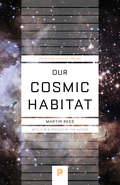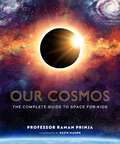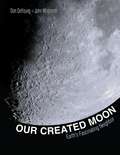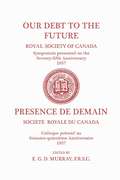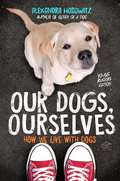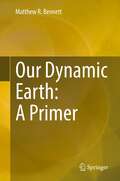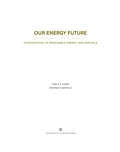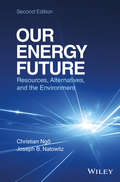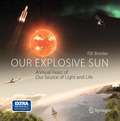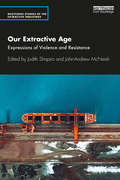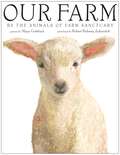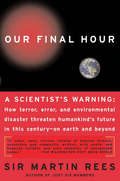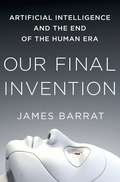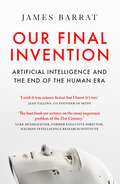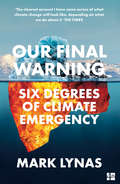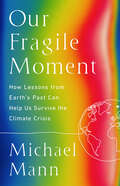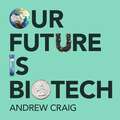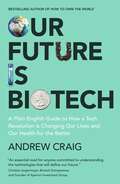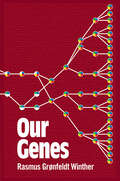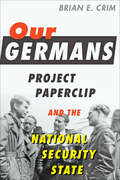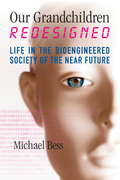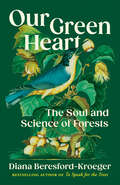- Table View
- List View
Our Cosmic Habitat
by Martin ReesOur universe seems strangely ''biophilic,'' or hospitable to life. Is this happenstance, providence, or coincidence? According to cosmologist Martin Rees, the answer depends on the answer to another question, the one posed by Einstein's famous remark: ''What interests me most is whether God could have made the world differently.'' This highly engaging book explores the fascinating consequences of the answer being ''yes.'' Rees explores the notion that our universe is just a part of a vast ''multiverse,'' or ensemble of universes, in which most of the other universes are lifeless. What we call the laws of nature would then be no more than local bylaws, imposed in the aftermath of our own Big Bang. In this scenario, our cosmic habitat would be a special, possibly unique universe where the prevailing laws of physics allowed life to emerge. Rees begins by exploring the nature of our solar system and examining a range of related issues such as whether our universe is or isn't infinite. He asks, for example: How likely is life? How credible is the Big Bang theory? Rees then peers into the long-range cosmic future before tracing the causal chain backward to the beginning. He concludes by trying to untangle the paradoxical notion that our entire universe, stretching 10 billion light-years in all directions, emerged from an infinitesimal speck. As Rees argues, we may already have intimations of other universes. But the fate of the multiverse concept depends on the still-unknown bedrock nature of space and time on scales a trillion trillion times smaller than atoms, in the realm governed by the quantum physics of gravity. Expanding our comprehension of the cosmos, Our Cosmic Habitat will be read and enjoyed by all those--scientists and nonscientists alike--who are as fascinated by the universe we inhabit as is the author himself.
Our Cosmos: The Complete Guide to Space for Kids
by Professor Raman PrinjaFrom planets and moons to black holes and asteroids, take a spectacular journey through the Universe with this definitive, illustrated guide for budding astronomers.Since the earliest moments of our civilization, space has captured the human imagination. Go on a tour of the Universe that is simply out of this world, taking in our planetary neighbors, our life-giving Sun, the awesome power of black holes, our nearby galaxies, and the creative power of stardust. See the passion of the people behind the space missions, the incredible inventions and spacecraft that allow us to see and travel farther than ever before, and, as humanity takes it first tentative steps towards these new worlds, be part of the journey that will define us forever.Discover everything you need to know about the ever-expanding universe in this must-have guide for children written by award-winning astrophysicist Professor Raman Prinja. With awe-inspiring illustrations by astrophysicist-turned-illustrator Suzie Mason.
Our Created Moon: Earth's Fascinating Neighbor
by Don DeYoung John WhitcombFor eons the moon has intrigued humanity. From its creation through the current issues of space exploration, the moon has been both a light in the night and a protective shield of earth placed perfectly by God, regulating our seasons and keeping our atmosphere purified. Billions of dollars have been spent to reach its surface and discover its secrets; open these pages and discover those secrets for yourself.
Our Debt to the Future: Royal Society of Canada, Symposium presented on the Seventy-fifth Anniversary 1957 (The Royal Society of Canada Special Publications #2)
by E.G.D. MurrayAT ITS ANNUAL MEETING in 1957, the Royal Society of Canada, celebrating the seventy-fifth anniversary of its foundation, departed from the accustomed pattern of its meetings. Instead of assembling in separate sections, Fellows from each Section of the Society were asked to contribute to a conspectus, focused by their specialized knowledge and trained discrimination, to reveal to the Society and to others certain trends and tendencies in Canada. Subjects and contributors are: "These Seventy-Five Years" (Presidential Address by W. A. Mackintosh); "The Roles of the Scientist and the Scholar in Canada's Future" (W. A. Mackintosh, David L. Thomson); "The Penalties of Ignorance of Man's Biological Dependence" (E. G. D. Murray, K. W. Neatby, I. McT. Cowan, G. H. Ettinger, R. H. Manske); "The Social Impact of Modern Technology" (N. A. M. MacKenzie, V. W. Bladen, E. W. R. Steacie, W. H. Watson); "Our Economic Potential in the Light of Science" (H. C. Gunning, J. E. Hawley, L. M. Pidgeon, B. S. Keirstead, Maurice Lamontagne); "Human Values and the Evolution of Society" (G.-H. Lévesque, T. W. M. Cameron, A. S. P. Woodhouse, R. Elie, Roy Daniells); "Let Us Look to Our Human Resources" (F. H. Underhill, J. K. W. Ferguson, L.-P. Dugal, W. B. Lewis). The volume is further prefaced by the address given by His Excellency the Right Honourable Vicent Massey, Governor-General of Canada, "The Weighing of Ayre."
Our Dogs, Ourselves -- Young Readers Edition: How We Live with Dogs
by Alexandra HorowitzThis middle grade adaptation of Our Dogs, Ourselves is an eye-opening, entertaining, and beautifully illustrated look about humans&’ complicated and sometimes contradictory relationship with man&’s best friend by New York Times bestselling author of Inside of a Dog—Young Readers Edition.We keep dogs and are kept by them. We love dogs and (we assume) we are loved by them. Even while we see ourselves in dogs, we also treat them in surprising ways. On the one hand, we let them into our beds, we give them meaningful names, make them members of our family, and buy them the best food, toys, accessories, clothes, and more. But we also shape our dogs into something they aren&’t meant to be. Purebreeding dogs has led to many unhealthy pups. Many dogs have no homes, or live out their life in shelters. How is it possible we can treat the same species in these two totally different ways? In Our Dogs, Ourselves Young Readers Edition, bestselling author of Inside of a Dog, Alexandra Horowitz reveals the odd, surprising, and contradictory ways we live with dogs.
Our Dynamic Earth: A Primer
by Matthew R. BennettStudents taking undergraduate degrees in geography, ecology, earth science, and environmental science frequently take an introductory unit in Physical Geography. Some will have not done any geography since their early teens, while others have more recent knowledge. This range of backgrounds can be challenging for both the instructor and the student, this primer aims to help. A primer is a readable introduction to a subject, more technical than a piece of popular science, but less detailed than a specialist textbook. It aims to give the reader a platform in a subject with which they may be unfamiliar, so that they can proceed simultaneously, or sequentially, to more advanced texts and information. Ideally the primer should have something for those without any knowledge, while also challenge and entertaining those who do. Not quite bedtime reading, but a step in that direction. Our Dynamic Earth introduces students to the Earth's origins, to plate tectonics, atmospheric and oceanographic circulation, as well as to a range of Earth surface processes. Idea to get you started in your studies.
Our Energy Future
by Carla S. Jones Stephen P. MayfieldOur Energy Future is an introductory textbook for the study of energy production, alternative and renewable fuels, and ways to build a sustainable energy future. Jones and Mayfield explore the creation and history of fossil fuels, their impact on the environment, and how they have become critical to our society. The authors also outline how adopting sustainable biofuels will be key to the future of energy stability and discuss a number of renewable energy options and biofuel feedstocks that are replacements for petroleum-based products. Our society is consuming energy at an alarming rate, and the authors warn that continuing fuel-usage patterns could permanently damage the environment. This book emphasizes the importance of continued scientific, agricultural, and engineering development while it outlines the political and environmental challenges that will accompany a complete shift from fossil fuels to renewable energy and biomass. Our Energy Future is an accessible resource for undergraduate students studying biofuels and bioenergy.
Our Energy Future
by Joseph Natowitz Christian NgoPresents an overview on the different aspects of the energy value chain and discusses the issues that future energy is facing This book covers energy and the energy policy choices which face society. The book presents easy-to-grasp information and analysis, and includes statistical data for energy production, consumption and simple formulas. Among the aspects considered are: science, technology, economics and the impact on health and the environment. In this new edition two new chapters have been added: The first new chapter deals with unconventional fossil fuels, a resource which has become very important from the economical point of view, especially in the United States. The second new chapter presents the applications of nanotechnology in the energy domain. Provides a global vision of available and potential energy sources Discusses advantages and drawbacks to help prepare current and future generations to use energy differently Includes new chapters covering unconventional fossil fuels and nanotechnology as new energy Our Energy Future: Resources, Alternatives and the Environment, Second Edition, is written for professionals, students, teachers, decision-makers and politicians involved in the energy domain and interested in environmental issues.
Our Explosive Sun
by Pal BrekkeThe Sun, which is our own star at the center of the Solar System, gives rise to all life on Earth and is the driver of photosynthesis in plants and the source of all food and energy for living things. As seen with the naked eye, the Sun appears as a static and quiet yellow disk in the sky. However, it is a stormy and ever-changing star that contributes much more than light and heat. For example, it is the source of the beautiful northern lights and can affect our technology-based society in many ways. Our Explosive Sun: A Visual Feast of our Source of Light and Life is a great introduction to the Sun for general readers as well as scientists who are not solar physicists. The book presents the basic properties of the Sun, describes how it has fascinated humans throughout history, and shows how it influences our current technologies. The book includes a large number of illustrations and video materials for SpringerExtras, along with a PowerPoint presentation that provides a useful resource for teachers and lectures.
Our Extractive Age: Expressions of Violence and Resistance (Routledge Studies of the Extractive Industries and Sustainable Development)
by Judith ShapiroOur Extractive Age: Expressions of Violence and Resistance emphasizes how the spectrum of violence associated with natural resource extraction permeates contemporary collective life. Chronicling the increasing rates of brutal suppression of local environmental and labor activists in rural and urban sites of extraction, this volume also foregrounds related violence in areas we might not expect, such as infrastructural developments, protected areas for nature conservation, and even geoengineering in the name of carbon mitigation. Contributors argue that extractive violence is not an accident or side effect, but rather a core logic of the 21st Century planetary experience. Acknowledgement is made not only of the visible violence involved in the securitization of extractive enclaves, but also of the symbolic and structural violence that the governance, economics, and governmentality of extraction have produced. Extractive violence is shown not only to be a spectacular event, but an extended dynamic that can be silent, invisible, and gradual. The volume also recognizes that much of the new violence of extraction has become cloaked in the discourse of "green development," "green building," and efforts to mitigate the planetary environmental crisis through totalizing technologies. Ironically, green technologies and other contemporary efforts to tackle environmental ills often themselves depend on the continuance of social exploitation and the contaminating practices of non-renewable extraction. But as this volume shows, resistance is also as multi-scalar and heterogeneous as the violence it inspires. The book is essential reading for activists and for students and scholars of environmental politics, natural resource management, political ecology, sustainable development, and globalization.
Our Farm: By the Animals of Farm Sanctuary
by Maya GottfriedMaya the cow, J.D. the piglet, Hilda the sheep, and a dozen more animals all speak directly to the reader, showing off their unique personalities in this wonderful collection of poems. Master watercolorist Robert Rahway Zakanitch provides a portrait that perfectly captures the essence of each creature. Together the poems and paintings add up to a picture of life on the friendliest farm around.Maya Gottfried based her poems on real animals from Farm Sanctuary, a safe haven for injured or abused farm animals with locations in New York and California.
Our Final Hour: How Terror, Error, and Environmental Disaster Threaten Humankind's Future in this Century--On Earth and Beyond
by Martin ReesA scientist known for unraveling the complexities of the universe over millions of years, Sir Martin Rees now warns that humankind is potentially the maker of its own demise--and that of the cosmos. Though the twenty-first century could be the critical era in which life on Earth spreads beyond our solar system, it is just as likely that we have endangered the future of the entire universe. With clarity and precision, Rees maps out the ways technology could destroy our species and thereby foreclose the potential of a living universe whose evolution has just begun. Rees boldly forecasts the startling risks that stem from our accelerating rate of technological advances. We could be wiped out by lethal "engineered" airborne viruses, or by rogue nano-machines that replicate catastrophically. Experiments that crash together atomic nuclei could start a chain reaction that erodes all atoms of Earth, or could even tear the fabric of space itself. Through malign intent or by mistake, a single event could trigger global disaster. Though we can never completely safeguard our future, increased regulation and inspection can help us to prevent catastrophe. Rees's vision of the infinite future that we have put at risk--a cosmos more vast and diverse than any of us has ever imagined--is both a work of stunning scientific originality and a humanistic clarion call on behalf of the future of life.
Our Final Hour: How Terror, Error, and Environmental Disaster in This Century Threaten humankind's Future on Earth and Beyond
by Martin ReesWhat we might do to destroy ourselves.
Our Final Invention: Artificial Intelligence and the End of the Human Era
by James Barrat[from inside flaps] "ARTIFICIAL INTELLIGENCE helps choose what books you buy, what movies you see, and even who you date. It puts the "smart" in your smartphone and soon it will drive your car. It makes most of the trades on Wall Street, and controls vital energy, water, and transportation infrastructure. But Artificial Intelligence can also threaten our existence. In as little as a decade, AI could match and then surpass human intelligence. Corporations and government agencies are pouring billions into achieving AI's Holy Grail--human-level intelligence. Once AI has attained it, scientists argue, it will have survival drives much like our own. We may be forced to compete with a rival more cunning, more powerful, and more alien than we can imagine. Through profiles of tech visionaries, industry watchdogs, and groundbreaking AI systems, Our Final Invention explores the perils of the heedless pursuit of advanced AI. Until now, human intelligence has had no rival. Can we coexist with beings whose intelligence dwarfs our own? And will they allow us to?"
Our Final Invention: Artificial Intelligence and the End of the Human Era
by James Barrat'I wish it was science fiction, but I know it's not.' Jaan Tallinn, co-founder of Skype'If you read just one book that makes you confront scary high-tech realities that we'll soon have no choice but to address, make it this one.' Washington Post Corporations and government agencies around the world have for years been pouring billions into achieving AI's Holy Grail - human-level intelligence. But once AI has attained it, scientists argue, it will have survival drives much like our own. We may be forced to compete with a rival more cunning, more powerful, and more alien than we can imagine.First published ten years ago, Our Final Invention predicted much of the artificial 'intelligence explosion' that is now ripping through our culture, and was named by Elon Musk as one of five books everyone should read about the future. Now with an urgent new preface, James Barrat's landmark work explores the ethics, history and future perils of the heedless pursuit of advanced AI. Until now, human intelligence has had no rival. Can we coexist with beings whose intelligence dwarfs our own? And will they allow us to?
Our Final Warning: Six Degrees of Climate Emergency
by Mark LynasWe are living in a climate emergency. But how much worse could it get? Will civilization collapse? Are we already past the point of no return? What kind of future can our children expect? Rigorously cataloguing the very latest climate science, Mark Lynas explores the course we have set for Earth over the next century and beyond. Degree by terrifying degree, he charts the likely consequences of global heating and the ensuing climate catastrophe. <P><P> At one degree – the world we are already living in – vast wildfires scorch California and Australia, while monster hurricanes devastate coastal cities. At two degrees the Arctic ice cap melts away, and coral reefs disappear from the tropics. At three, the world begins to run out of food, threatening millions with starvation. At four, large areas of the globe are too hot for human habitation, erasing entire nations and turning billions into climate refugees. At five, the planet is warmer than for 55 million years, while at six degrees a mass extinction of unparalleled proportions sweeps the planet, even raising the threat of the end of all life on Earth. <P><P> These escalating consequences can still be avoided, but time is running out. We must largely stop burning fossil fuels within a decade if we are to save the coral reefs and the Arctic. If we fail, then we risk crossing tipping points that could push global climate chaos out of humanity’s control. <P><P> This book must not be ignored. It really is our final warning.
Our Fragile Moment: How Lessons from Earth's Past Can Help Us Survive the Climate Crisis
by Michael E. MannIn this sweeping work of science and history, the renowned climate scientist and author of The New Climate War shows us the conditions on Earth that allowed humans not only to exist but thrive, and how they are imperiled if we veer off course. For the vast majority of its 4.54 billion years, Earth has proven it can manage just fine without human beings. Then came the first proto-humans, who emerged just a little more than 2 million years ago—a fleeting moment in geological time. What is it that made this benevolent moment of ours possible? Ironically, it&’s the very same thing that now threatens us—climate change. The drying of the tropics during the Pleistocene period created a niche for early hominids, who could hunt prey as forests gave way to savannahs in the African tropics. The sudden cooling episode known as the &“Younger Dryas&” 13,000 years ago, which occurred just as Earth was thawing out of the last Ice Age, spurred the development of agriculture in the fertile crescent. The &“Little Ice Age&” cooling of the 16th-19th centuries led to famines and pestilence for much of Europe, yet it was a boon for the Dutch, who were able to take advantage of stronger winds to shorten their ocean voyages. The conditions that allowed humans to live on this earth are fragile, incredibly so. Climate variability has at times created new niches that humans or their ancestors could potentially exploit, and challenges that at times have spurred innovation. But there&’s a relatively narrow envelope of climate variability within which human civilization remains viable. And our survival depends on conditions remaining within that range. In this book, renowned climate scientist Michael Mann will arm readers with the knowledge necessary to appreciate the gravity of the unfolding climate crisis, while emboldening them—and others--to act before it truly does become too late.
Our Future is Biotech: A Plain English Guide to How a Tech Revolution is Changing Our Lives and Our Health for the Better
by Andrew Craig"An essential read for anyone committed to understanding the technologies that will define our future." CHRISTIAN ANGERMAYER, BIOTECH ENTREPRENEUR AND FOUNDER OF APEIRON INVESTMENT GROUPWelcome to the biotech revolutionIn the last century, technology has transformed the human experience across the world. This has been super-charged by the arrival of the internet, smart phones, AI and machine learning, and created trillion-plus dollar companies and household names like Apple, Amazon, Google and Microsoft.Our Future is Biotech explains why biotech is next: because our biggest remaining challenges as a species concern biological systems.Biotech companies will solve our most intractable problems, from cancer, dementia, obesity and diabetes to elderly care, mental health conditions, and even clean power generation, agricultural production and environmental degradation.Biotech means that we can all live better, safer, healthier, wealthier, happier, and longer lives.The industry has already delivered "miracle cures" for several diseases, and there is more to come. But despite this, few people are aware of the phenomenal progress being made. Our Future is Biotech addresses this, explaining what biotech is, what is coming next, and how you might profit from it too.Tech has been the most important theme for human progress for the last century. Biotech is next.
Our Future is Biotech: A Plain English Guide to How a Tech Revolution is Changing Our Lives and Our Health for the Better
by Andrew Craig"An essential read for anyone committed to understanding the technologies that will define our future." CHRISTIAN ANGERMAYER, BIOTECH ENTREPRENEUR AND FOUNDER OF APEIRON INVESTMENT GROUPWelcome to the biotech revolutionIn the last century, technology has transformed the human experience across the world. This has been super-charged by the arrival of the internet, smart phones, AI and machine learning, and created trillion-plus dollar companies and household names like Apple, Amazon, Google and Microsoft.Our Future is Biotech explains why biotech is next: because our biggest remaining challenges as a species concern biological systems.Biotech companies will solve our most intractable problems, from cancer, dementia, obesity and diabetes to elderly care, mental health conditions, and even clean power generation, agricultural production and environmental degradation.Biotech means that we can all live better, safer, healthier, wealthier, happier, and longer lives.The industry has already delivered "miracle cures" for several diseases, and there is more to come. But despite this, few people are aware of the phenomenal progress being made. Our Future is Biotech addresses this, explaining what biotech is, what is coming next, and how you might profit from it too.Tech has been the most important theme for human progress for the last century. Biotech is next.
Our Future is Biotech: A Plain English Guide to How a Tech Revolution is Changing Our Lives and Our Health for the Better
by Andrew Craig"An essential read for anyone committed to understanding the technologies that will define our future." CHRISTIAN ANGERMAYER, BIOTECH ENTREPRENEUR AND FOUNDER OF APEIRON INVESTMENT GROUPWelcome to the biotech revolutionIn the last century, technology has transformed the human experience across the world. This has been super-charged by the arrival of the internet, smart phones, AI and machine learning, and created trillion-plus dollar companies and household names like Apple, Amazon, Google and Microsoft.Our Future is Biotech explains why biotech is next: because our biggest remaining challenges as a species concern biological systems.Biotech companies will solve our most intractable problems, from cancer, dementia, obesity and diabetes to elderly care, mental health conditions, and even clean power generation, agricultural production and environmental degradation.Biotech means that we can all live better, safer, healthier, wealthier, happier, and longer lives.The industry has already delivered "miracle cures" for several diseases, and there is more to come. But despite this, few people are aware of the phenomenal progress being made. Our Future is Biotech addresses this, explaining what biotech is, what is coming next, and how you might profit from it too.Tech has been the most important theme for human progress for the last century. Biotech is next.
Our Future is Biotech: A Plain English Guide to How a Tech Revolution is Changing Our Lives and Our Health for the Better
by Andrew Craig"An essential read for anyone committed to understanding the technologies that will define our future." CHRISTIAN ANGERMAYER, BIOTECH ENTREPRENEUR AND FOUNDER OF APEIRON INVESTMENT GROUPWelcome to the biotech revolutionIn the last century, technology has transformed the human experience across the world. This has been super-charged by the arrival of the internet, smart phones, AI and machine learning, and created trillion-plus dollar companies and household names like Apple, Amazon, Google and Microsoft.Our Future is Biotech explains why biotech is next: because our biggest remaining challenges as a species concern biological systems.Biotech companies will solve our most intractable problems, from cancer, dementia, obesity and diabetes to elderly care, mental health conditions, and even clean power generation, agricultural production and environmental degradation.Biotech means that we can all live better, safer, healthier, wealthier, happier, and longer lives.The industry has already delivered "miracle cures" for several diseases, and there is more to come. But despite this, few people are aware of the phenomenal progress being made. Our Future is Biotech addresses this, explaining what biotech is, what is coming next, and how you might profit from it too.Tech has been the most important theme for human progress for the last century. Biotech is next.
Our Genes: A Philosophical Perspective on Human Evolutionary Genomics
by Rasmus Grønfeldt WintherSituated at the intersection of natural science and philosophy, Our Genes explores historical practices, investigates current trends, and imagines future work in genetic research to answer persistent, political questions about human diversity. Readers are guided through fascinating thought experiments, complex measures and metrics, fundamental evolutionary patterns, and in-depth treatment of exciting case studies. The work culminates in a philosophical rationale, based on scientific evidence, for a moderate position about the explanatory power of genes that is often left unarticulated. Simply put, human evolutionary genomics - our genes - can tell us much about who we are as individuals and as collectives. However, while they convey scientific certainty in the popular imagination, genes cannot answer some of our most important questions. Alternating between an up-close and a zoomed-out focus on genes and genomes, individuals and collectives, species and populations, Our Genes argues that the answers we seek point to rich, necessary work ahead.
Our Germans: Project Paperclip and the National Security State
by Brian E. CrimA gripping history of one of the United States' most controversial Cold War intelligence operations.Project Paperclip brought hundreds of German scientists and engineers, including aerospace engineer Wernher von Braun, to the United States in the first decade after World War II. More than the freighters full of equipment or the documents recovered from caves and hastily abandoned warehouses, the German brains who designed and built the V-2 rocket and other "wonder weapons" for the Third Reich proved invaluable to America's emerging military-industrial complex. Whether they remained under military employment, transitioned to civilian agencies like NASA, or sought more lucrative careers with corporations flush with government contracts, German specialists recruited into the Paperclip program assumed enormously influential positions within the labyrinthine national security state. Drawing on recently declassified documents from intelligence agencies, the Department of Defense, the FBI, and the State Department, Brian E. Crim's Our Germans examines the process of integrating German scientists into a national security state dominated by the armed services and defense industries. Crim explains how the Joint Intelligence Objectives Agency enticed targeted scientists, whitewashed the records of Nazis and war criminals, and deceived government agencies about the content of security investigations. Exploring the vicious bureaucratic rivalries that erupted over the wisdom, efficacy, and morality of pursuing Paperclip, Our Germans reveals how some Paperclip proponents and scientists influenced the perception of the rival Soviet threat by volunteering inflated estimates of Russian intentions and technical capabilities. As it describes the project's embattled legacy, Our Germans reflects on the myriad ways that Paperclip has been remembered in culture and national memory. As this engaging book demonstrates, whether characterized as an expedient Cold War program born from military necessity or a dishonorable episode, the project ultimately reflects American ambivalence about the military-industrial complex and the viability of an "ends justifies the means" solution to external threats.
Our Grandchildren Redesigned
by Michael BessA panoramic overview of biotechnologies that can endlessly boost human capabilities and the drastic changes these "superhuman" traits could trigger Biotechnology is moving fast. In the coming decades, advanced pharmaceuticals, bioelectronics, and genetic interventions will be used not only to heal the sick but to boost human physical and mental performance to unprecedented levels. People will have access to pills that make them stronger and faster, informatic devices will interface seamlessly with the human brain, and epigenetic modification may allow people to reshape their own physical and mental identities at will.Until recently, such major technological watersheds--like the development of metal tools or the industrialization of manufacturing--came about incrementally over centuries or longer. People and social systems had time to adapt: they gradually developed new values, norms, and habits to accommodate the transformed material conditions. But contemporary society is dangerously unprepared for the dramatic changes it is about to experience down this road on which it is already advancing at an accelerating pace.The results will no doubt be mixed. People will live longer, healthier lives, will fine-tune their own thought processes, and will generate staggeringly complex and subtle forms of knowledge and insight. But these technologies also threaten to widen the rift between rich and poor, to generate new forms of social and economic division, and to force people to engage in constant cycles of upgrades and boosts merely to keep up. Individuals who boost their traits beyond a certain threshold may acquire such extreme capabilities that they will no longer be recognized as unambiguously human.In this important and timely book, prize-winning historian Michael Bess provides a clear, nontechnical overview of cutting-edge biotechnology and paints a vivid portrait of a near-future society in which bioenhancement has become a part of everyday life. He surveys the ethical questions raised by the enhancement enterprise and explores the space for human agency in dealing with the challenges that these technologies will present.Headed your way over the coming decades: new biotechnologies that can powerfully alter your body and mind.The possibilities are tantalizing:* Rejuvenation therapies offering much longer lives (160 and even beyond) in full vigor and mental acuity * Cognitive enhancement through chemical or bioelectronic means (the rough equivalent of doubling or tripling IQ scores) * Epigenetic tools for altering some of your genetically influenced traits at any point in your lifetime (body shape, athletic ability, intelligence, personality) * Bioelectronic devices for modulating your own brain processes, including your "pleasure centers" (a potentially non-stop high) * Direct control of machines by thought, and perhaps direct communication with other people, brain-to-brain (a new dimension of sharing and intimacy) But some of the potential consequences are also alarming: * A growing rift between the biologically enhanced and those who can't afford such modifications * A constant cycle of upgrades and boosts as the bar of "normal" rises ever higher--"Humans 95, Humans XP, Humans 8" * The fragmentation of humankind into rival "bioenhancement clusters" * A gradually blurring boundary between "person" and "product" * Extreme forms of self-modification, with some individuals no longer recognized as unambiguously humanFrom the Hardcover edition.
Our Green Heart: The Soul and Science of Forests
by Diana Beresford-KroegerIn this inspiring culmination of Diana Beresford-Kroeger&’s life&’s work as a botanist, biochemist, biologist and poet of the global forest, she delivers a challenge to us all to dig deeper into the science of forests and the ways they will save us from climate breakdown—and then do our part to plant and protect them.As the last child in Ireland to receive a full Druidic education, Diana Beresford-Kroeger has brought an unusual and ancient holistic attitude to the science of trees, which has led her to many fresh insights into how closely we are tied to one another and to the natural world. Her influential message is to pay rapt attention to trees, because they are the green heart of the living world. Forests are our lungs, our medicine, our oxygen and the renewal of our soil. Planting the right trees in the right places, protecting the last virgin forests and working to create new ones is our best means to ensure a future for our children and grandchildren on this burning earth.Each of the essays gathered in Our Green Heart show us a slice of the natural world through Diana&’s unique lens, illuminating the way our health, individually and as a species, is tied to the health of the forest—a tie we ignore at our peril. She maps the science that still needs to be done—there is so much we don&’t know about the ways trees and forests work—but also, eloquently, shows us the path to survival that her own science has revealed, the &“bioplan&” or blueprint for the connectivity of life in nature. If we realize that even the flowerpot on our doorstep is a natural habitat, and plant it according to its bioplan, we will be aiding and abetting life rather than destroying it.
